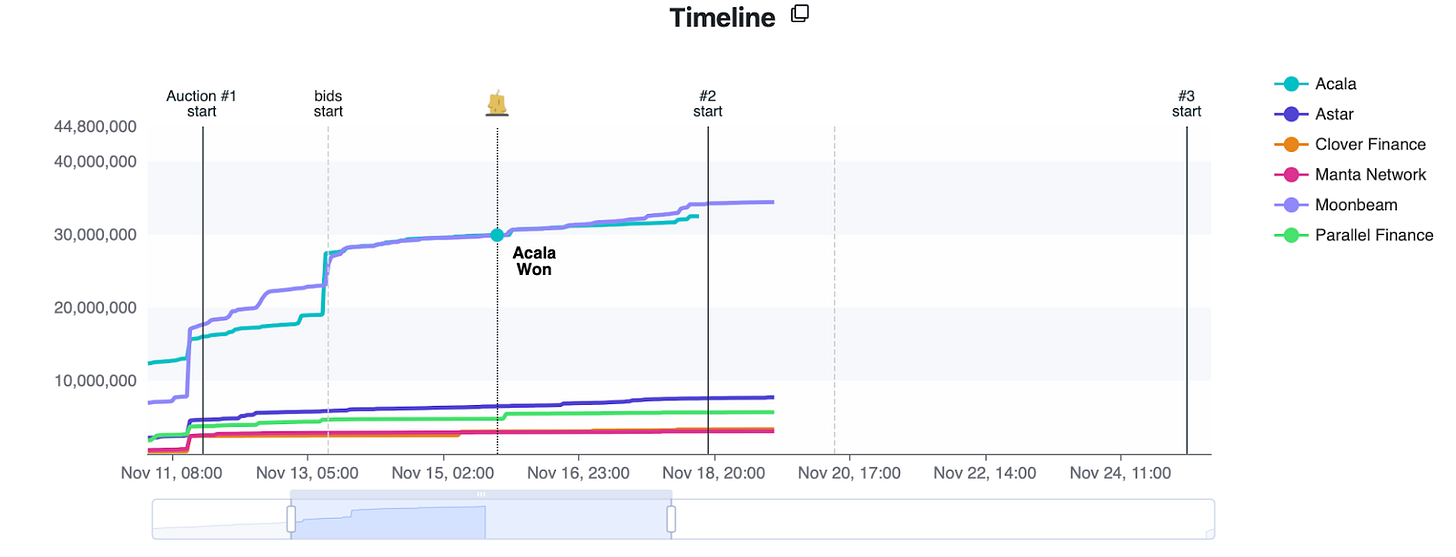Dot Pulse #14 — Acala Wins First Auction & Bifrost Deep Dive
Learn about the Bifrost parachain, detailed stats about Polkadot crowdloans, Karura & Moonriver farms and governance watcher! 📣
Welcome to Dot Pulse, your window into the Polkadot DeFi ecosystem.
If you’re a humble farmer looking to learn more about Polkadot’s DeFi opportunities, or even if you’re a seasoned DOT/KSM staker, this newsletter is the place to find all the latest events in Dot land.
Subscribe now to receive regular updates about Polkadot development, crowdloans and parachain auctions, new exciting DeFi projects, and anything else worth knowing about Polkadot.
We’re rounding out the first batch of Kusama parachains with Bifrost, a parachain devoted to unlocking liquidity. This one’s very interesting because Bifrost is very specialized.
Bifrost: The Liquid Staking Parachain
The core idea behind Bifrost is that it wants to unlock liquidity. Which kinds? Well…
The biggest application is of course Proof of Stake liquidity. As we’ve covered in the past for Karura, Polkadot aims to have around 60% of its entire supply tied up in staking. Now that’s a lot of tokens not available on the market!
The unfortunate consequence of having vast portions of your supply locked is that when people do begin to feel like they need to sell their assets, the market will feel a deluge of new supply that will overwhelm even the bravest of liquidity providers. Volatility will spike, people will want to dump even harder… It’s a vicious circle of liquidity.
There’s also the pesky little thing that you can’t use staked assets anywhere else, so it becomes a choice of either staking yield OR crowdloans, farms etc.
Removing liquidity to chase the next 1000% APR farm is not a good thing for the network, and indeed there is an inverse relationship between the security of a PoS network and the amount of free liquidity it has available.
Bifrost Liquid Staking
This is where Bifrost comes in. It features a nifty system of essentially trustless liquid staking powered in part by the BNC token. As a user, all you need to do is to stake your DOT/KSM into the Bifrost system to obtain vDOT or vKSM, the staking derivative token representing staked DOT.
The assets supplied into Bifrost pools are then used by Bidders who run the blockchain nodes and use the assets within the pool as their stake. In order to access them, they need to stake BNC which is liable to get slashed if the node performs poorly or misbehaves.
This is a very useful feature as many liquid staking protocols ultimately rely on a centrally-curated list of validators. The BNC bond ensures that Bidders behave properly and are incentivized to keep their nodes operating smoothly.
Bifrost initially focuses on Polkadot and Kusama, but it aims to cover most other PoS blockchains as well. The Bifrost parachain acts as the central hub of this system, making it essential that the platform remains at least as expensive to break as the assets it is securing. This is why Bifrost chose to become a parachain, as this enables it to piggyback off Polkadot’s entire security budget and offload this crucial task.
Unfortunately, the liquid staking system isn’t live yet. But remember how we said that Bifrost wants to unlock everything? This goes for crowdloans too!
The SALP Protocol
Standing for Slot Auction Liquidity Protocol, SALP is a liquid staking system for crowdloans. As you may know, a crowdloan locks the contributor’s KSM/DOT for the entire duration of the lease, which is around 1-2 years. This means they can’t sell it or do anything else with the tokens, which can be an issue given how fast crypto moves!
Instead, you can contribute to crowdloans through SALP and receive two derivative tokens for it, vsKSM/vsDOT and vsBond. This effectively splits your contribution into two parts: a generic derivative token that can be sold on the open market, and the vsBond, which is used to redeem the underlying tokens one-for-one when the parachain slot expires. The bond is connected to a specific parachain and lease, so it’s not quite as fungible as the main vsKSM token.
Initial minters of the bond receive the token rewards from the project, and they can sell the vsKSM at any point to unlock part of their value. Its price will of course be lower than one full KSM, so it’s a risk that you need to calculate: will you be able to buy back vsKSM at the same price? Can you make up for the difference with staking or farming?
SALP is currently running on most Kusama and Polkadot parachain auctions, and it needs to be set up specifically for each right now as XCM is still unreleased. The team is generally quite fast at it and you even get bonuses in BNC or the project’s tokens for using SALP!
Crowdloan and deployment
Like with Phala, Bifrost plans to have only one token. Its rewards for the Kusama auction were 7.5% of the total supply, after initially putting up just 3.75% (the race got heated!). Overall, the community will get 50% of the entire supply.
The ROI for crowdloan contributors is around 23%, which sadly quite low for the first batch. But with the release of DOT/KSM liquid staking the platform is likely to get a burst of activity!
Acala won the first slot! The race with Moonbeam was extremely tight but Acala ended up snatching the historical first slot by a hair (More on this below).
On Kusama, things are proceeding steadily. Quartz became the latest parachain to join this round with 54k KSM. This is by far the cheapest slot yet!
Active Crowdloans (Polkadot)
TL;DR: Crowdloan participants receive 10% of the GLMR supply. Learn more about it in the Moonriver deep dive.
TL;DR: Offering a nice 20% of the supply, Astar is the main network for the Shiden canary we covered in the past.
Active Crowdloans (Kusama)
TL;DR: The DeFi-focused parachain is now in a comfortable lead of 34k KSM. Contributors are bidding for 12.5% of the supply.
TL;DR: This social media platform (kind of like a crypto Facebook) is offering 16.5% of supply for its crowdloan. Quickly collected 9.2k KSM after entering the race this week.
Active Farms
Earn KAR by staking on Karura DEX
Yields are now 22% APR (or 45% with loyalty bonus) for KAR/KSM.
KSM/LKSM farm has 13% APR (45% with loyalty)
KAR/kUSD offers an APR of 63%, 90% with loyalty.
Earn KAR + BNC (Bifrost tokens) when staking kUSD/BNC
APR is 133% with loyalty, 39% without.
Sushi farms on Moonriver are stable with a few low TVL >500% APR pools, but steady triple digits overall.
Solarbeam farms returned in strength this week. Quite a few Pool1s actually yielding triple digits, more than the Pool2 now!
Acala is the official winner of Polkadot’s first parachain auction!
The race was extremely heated between Acala and Moonbeam. There was barely any distance for most of the race, and ultimately the winning margin was just 0.056% of their total raise!

Acala won despite losing the lead later in the run because of the candle auction mechanism. Sadly for Moonbeam, the system ended up randomly choosing the period in the middle of the auction when Acala maintained the slimmest of leads!
So Acala won, but it was mostly an honor thing. Parachains start at the same time on Polkadot, so nobody has any advantages here. Moonbeam still towers over everyone else left, so most likely they’ll take the second slot.
The folks at SubQuery compiled a pretty useful economic analysis of the crowdloans. The gist is that it was a bit of a whale tussle!

There were four addresses that together contributed over 70% of all DOT in the crowdloans (so far). In particular we had 1xhXb5ZjsKpN1xcvTNMuThndfb1WP9saLKMpNxofGm64U2X who we’ll call the enjoyooor (or hedgoor, take your pick), who contributed 23.5 million DOT ($987 million) to basically all crowdloans. Moonbeam got the largest allocation (9 million DOT) but the enjoyoor also sent a few millies to Clover, Acala, Parallel, Astar, Litentry and Manta.
Then we have 132zsjMwGjNaUXF5XjUCDs2cDEq9Qao51TsL9RSUTGZbinVK, codename cheerleadooor, who was both the largest single contributor and a 100% Acala fan. The chearleadoor sent a whopping 24 million DOT (basically $1 billion) just to Acala, basically pushing them to victory.
But overall there were 67,000 unique addresses participating in crowdloans so far, with a median contribution of 12 DOT and a 467 DOT average. This is definitely not a bad result especially if you consider that the enjoyoor might just be an exchange contributing for its users!
Bifrost added support for staked DOT derivatives for the Acala crowdloan (as well as Astar and Moonbeam).
Moonriver teams up with RMRK, a Kusama-native NFT protocol, in order to provide advanced features for NFT developers, creators, and collectors across the Kusama ecosystem.
Project Venkman chose Acala to launch a variety of brand engagement solutions using on-chain loyalty points and NFTs. All Acala crowdloan participants with a registered email on the Acala newsletter are eligible for a future Venkman and theCHIVE NFT drop.
Parallel Finance has launched a crowdloan product to incentivize crowdloan participants.
(Kusama) Motion 396 a proposal for the phase 2 of an educational video on Polkadot and Kusama Networks elements, dynamics and protocols in place to visualize the Polkadot ecosystem structure, by NubbleBits.
(Kusama) Treasury Proposal 119 a proposal to obtain funding for the continued operation, maintenance and development of the Parachains.info website.
All info in this newsletter is purely educational and should only be used to inform your own research. We're not offering investment advice, endorsement of any project or approach, or promise of any outcome. This is prepared using public information and couldn't possibly account for anyone's specific goals or financial situation. Be careful and keep up the honest work!











